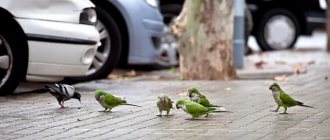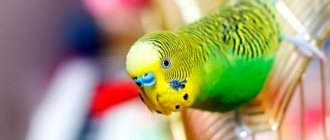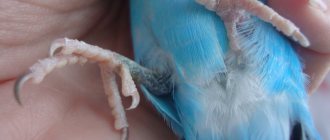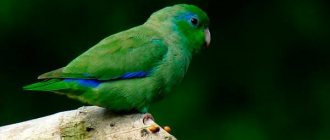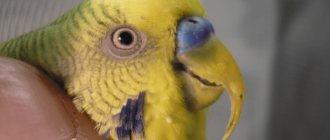The photo shows Nessie the cockatoo. HER journey story is below. The owner of the bird is Lyudmila Mengele.
In the video below, you can clearly see that a parrot that cannot fly (that is, it cannot fly! Because birds need to learn to fly), accidentally flying away and sitting on a high tree, does not move.
The bird is so scared that it allows itself to be pulled together, although it is afraid of humans - this can be seen and heard when the macaw is grabbed.
video of the capture of a green-winged macaw that flew away while out for a walk
So, option one
How to catch a parrot in a cage
While the parrot is flying around the room, you should not take your eyes off him and leave him alone. Without supervision, this bird runs the risk of becoming entangled in curtains, getting stuck under a sofa or closet, crawling under a blanket or pillow, and even suffocating.
Interesting! Normally, 1–3 hours of free flight around the room is enough.
After a long flight, the pet will get hungry and fly into the cage on its own. But if the time for a walk is coming to an end, and the pet is in no hurry to return, there are several effective methods to return it home.
- Pour food. It's easier to cage a parrot when it's hungry. It is enough to demonstratively pour the grain mixture into the feeder. You can put some food in your palm and hand it to the bird. When she sits on your hand to eat, carefully move it.
- Offer treats. Instead of grain mixture, you can put slices of fruits, vegetables or other treats in the cage.
- Lure with a toy. You can replace food with your favorite toy, or place a mirror or bright element inside the cage. This will interest the bird and make him come back.
Interesting! A trained parrot returns to its cage more easily. It is enough to call him by name at the end of the walk, and he will immediately sit on his owner’s hand.
Should a parrot be released from its cage?
Experts and most amateurs answer this question unequivocally in the affirmative. The fact is that a feathered pet, even if it was born in captivity, retains a natural need to move. If it is not satisfied, the pet's quality of life will deteriorate significantly.
If a budgie (like any other) is not allowed out of the house, the following negative consequences will appear:
- There will be problems with the health of the feathered pet. Wings without constant flight will weaken and may even atrophy. And abundant food consumption without a burst of energy leads to obesity.
- Mental problems will arise. The lack of full movement leads to depression.
- Contact between the owner and the pet will worsen. It is much more difficult to tame a bird that is constantly in a cage than one that periodically flies out of it.
So, the answer to the question of why let a parrot out of its cage is very clear. How to let a parrot out of its cage for the first time? The first release should be done when the bird is already accustomed to the new cage, owner and home environment and is sufficiently tamed. You can simply leave the cage door open. Then the bird, having carefully looked around, will fly out of its house. And if the pet is already accustomed to sitting on the owner’s hand, you can try to get it out of the cage. If the parrot does not leave the cage, it means that he is still afraid of something. In such a situation, experts advise not to force the process, but to show tact and patience.
When releasing a parrot, you must follow all safety precautions:
- Close windows and doors tightly to prevent your pet from flying away.
- Isolate cats and dogs.
- Cover the mirrors with sheets.
- If possible, remove electrical wires.
How to catch a parrot in a room
If the parrot has flown away from the cage and does not want to return, you can use the manual method. Put on gloves and hide in the corner of the room or behind a closet. Next, the assistant must turn off the lights in the room. A bird in the dark will not fly, but will sit somewhere. Here you need to carefully pick it up and move it into the cage. In this case, gloves are needed so that the pet does not smell its owner.
Imitation of the evening can also be used in this situation. You can return the parrot back to its cage using its natural instincts. If he sees the evening come, he will return to his home.
Important! Some birds become frightened by the harsh darkness and begin to fly chaotically around the room. In this case, it is recommended to immediately turn on the light and choose another method.
If the parrot is trained, you can return it to the cage using a command, whistle or ringing of a bell. Every time a bird flies into a cage or is brought in by its owner, it is necessary to say the command “Home,” whistle something, or use another signal.
How to catch an untrained pet
When trying to catch a parrot and drive it into the house, do not shout or wave your arms. This way you will frighten the bird even more, which still does not trust you and does not come into your arms. The pet may rush around the room and start hitting furniture and windows. This often ends in serious injuries when the legs fail, the wings break, the bird gets a concussion, etc.
Of all the methods proposed in the article on how to catch a parrot in a room, the absence of lighting (turning off the lights or closing the curtains) will help you. The darkness disorients the bird, it sits in one place, and then you can carefully pick it up. It’s even better if you illuminate the cage, and then the pet will fly out of the darkness into the light. As soon as he is in his house, quickly, but without sudden movements, close it.
How not to catch a parrot
Catching a parrot in a room is a long and laborious process. The owner may simply run out of patience. And in this case, a natural desire arises to catch him as quickly as possible. However, rushing this process can only do harm.
When catching a flying budgie, cockatiel or other member of the family, the following actions should not be allowed:
- throw a blanket over the fragile bird;
- waving a towel in an attempt to drive the pet;
- catch with your hands when the light is on;
- try to cover the bird with a cage without a bottom.
Interesting! To lure a bird into a cage, it is necessary to create better conditions in it than in freedom. Give treats, talk to the parrot while he is in it, clean up litter frequently, and provide plenty of toys.
The parrot flew away: how to find it?
If trouble does happen, then your actions will depend on whether you saw the moment of escape or not.
Although in any case, first of all you need to calm down and keep your mind cool.
Do not scream or try to chase the parrot, otherwise you will scare it to such an extent that it will fly too far.
Draw in your head the trajectory of its movement and at least approximately understand where it could fly.
Most likely, there will be trees around, in the crown of which the parrot disappeared.
But even if they are not nearby, then you need to determine the direction of the bird’s flight as accurately as possible.
If you returned to the room when the parrot had already flown away, you will have to turn on your intuition, put yourself in the pet’s place, wondering where it could fly.
How would you behave in such a situation, having spent your whole life in one place, and then finding yourself in a huge and completely unexplored space?
That's right, they would find a secluded place and hide, try to study the situation - this is exactly what the bird will most likely do.
Most likely, he will not even respond to your calls to go back for some time, he will be so scared.
To distract the parrot and direct his thoughts in the right direction, that is, towards returning home, you must focus his attention on some familiar thing.
Maybe he has a cagemate with whom he was very friendly, or is he attracted to some kind of sound?
Think about it, because you need to make your pet overcome fear and take off, and for this you need motivation.
What to do if you couldn't catch a parrot
If he flew out and could not be caught before nightfall, you can resort to drastic measures. It is not recommended to leave the bird flying in the room overnight. If all safe measures do not help, you can use a net. This method is only suitable for small breeds, since large birds are touchy and vindictive. After using this method, they can take revenge on their owner.
Important! The radical method is dangerous due to the deterioration of the relationship between a person and a pet.
Why did the parrot fly away?
In fact, these situations are not caused by the parrot’s desire to run away from you, but by your inattention.
One has only to retreat to the kitchen for a few moments, leaving the door or window open, and the bird will immediately feel like a great explorer and fly there.
After all, you remember that parrots are extremely curious and freedom-loving birds, and that is why it is so difficult for them to resist flying into the unknown.
If the open door leads to the entrance, then you are lucky and catching the fugitive will not be difficult.
But if it flew out the window, or you live in a private house, then the situation becomes extremely complicated. It becomes especially creepy if there is winter outside the window and snow, which the bird has never seen.
Finding himself in such conditions, he can experience extreme stress, and his further behavior is almost impossible to predict.
Unfortunately, it is impossible to explain to the bird in advance that nothing good awaits him outside the house.
Therefore, every effort must be made to ensure that such a situation never arises.
The first thing you need to do is take care of the windows.
In summer, mosquito nets should be installed, especially in those rooms where the parrot is in free flight.
In winter, of course, the windows should be closed, although most likely this will be the case.
If you are walking somewhere with a bird on the street, then carefully watch that it does not open the door of the carrying cage and fly away. Parrots are very smart birds and this will not be difficult for them.
How to catch a parrot on the street
A pet can fly out into the street due to the owner’s carelessness. The methods of catching it in this case will differ depending on whether the bird is flying or non-flying.
Capturing a flightless bird
If a flightless parrot flies outside, it will not go far. Such birds land on a tree, the roof of a house or other hill. In this situation, it is important to visually find the pet and try to remove it.
Important! Flightless parrots can hide under cars. These and other dangerous places should be checked first.
Flightless bird left on the street at night
If the parrot flew away in the evening and it was not possible to remove it, most likely it will remain in the same place until the morning. Attempts to catch him in the dark may end in failure. The bird will simply fly away and get lost in the twilight. In the morning, a pet that has flown away can be removed with the help of the Ministry of Emergency Situations or industrial climbers.
The parrot flew away in an unknown direction.
In this situation, after walking around the area within a kilometer radius (this is the average distance at which most shocked parrots try to land), you need to notify as many people as possible about the missing bird. To do this, use all available means of communication - first of all, post advertisements in your area indicating the phone number and characteristics of the bird; write for example:
“The cockatoo, a large white parrot with a tuft, flew away”
“A macaw flew away - a large parrot with a huge beak and a long tail...” indicate the main color (blue-yellow or green-red)
“The Amazon, the big green parrot, flew away”
Future precautions
Agree, if the parrot flew away, it means you were not as prudent as possible. In the future, when getting poultry, you need to make sure that there are protective nets on the windows and vents. You should also be careful when opening doors, as birds can fly out through them.
If you want to purchase another parrot, in addition to the above precautions, you should put an identification ring or chip on the bird. It would also be a good idea to familiarize your pet with its environment so that if it runs away, it can easily return home. Train your parrot to respond to his name. It is also very useful to teach your feathered friend to come to you on command.
Tip #4 – catching with your hands
If all of the above methods do not help lure the wavy into the cage, then you can resort to more radical measures, such as catching the bird with your hands.
To do this, you will need the support of another person who, at your signal, will turn off the lights in the room. And since parrots don’t see well in the dark, grabbing it with your hands will be as easy as shelling pears.
And yes, don’t forget to wear gloves, because these birds remember smells well, and if he smells your scent, then in the future it will be very difficult for you to establish friendly relations with your feathered pet.
After you catch the parrot and place it back in the cage, move as far away from it as possible and only then turn on the light. If you do everything quickly, without unnecessary noise, the bird will not even understand what happened to it.
Common reasons why a bird flies away
In most cases, the parrot flies away by pure chance when the owner forgets to close the window or door, letting the pet fly around the room. The person doesn’t even have time to react, the bird flies out into the street so quickly.
These nimble creatures can flutter out of a slightly open door when you leave for work or let guests into your home. Moreover, you may not immediately notice the disappearance of your pet.
What to do when the parrot flies away?
When wondering: how to catch a flying parrot on the street, you should turn to the habits of the bird. You need to understand that a parrot acts instinctively. Instincts will tell a bird that first flies out of the house into the open space, onto the street, to hide in the first tree it encounters on the way.
If a parrot flew out the window of the house before your eyes, look where it went. Calmly, without shouting or panic, follow him. Follow the direction the bird was moving. Pay attention to the trees that are located near the place where the parrot flew. Most likely, he hid in one of them.
If you find that the parrot has disappeared after some time, go look for it in the nearby trees from the place through which it could have flown out. A domestic parrot follows its instincts, it is scared, it is in a stressful state on the street, therefore, the likelihood that it will hide in the crown of the nearest tree is high.
Try to attract the bird's attention. Call the parrot. Turn on music that is familiar to him. If the parrot did not live alone, put its relative in a cage and take it with you - this will make the search easier. The parrot will respond to sounds familiar to it and fly out of the tree crown towards you.
Try not to make sudden movements; if you notice a bird in a tree, approach the parrot slowly and carefully. Remember, if you scare the bird, it will continue its journey down the street and it will be more difficult for you to find it.
Place the parrot's cage near the tree where you have noticed it or suspect that it is there. Try to loudly pour food into the feeder, this sound will attract the attention of your pet.
Be patient, wait until the parrot flies into the cage and then close it. It is impossible to grab a parrot with your hands by running up to it. Understand that you can return the bird home only through cunning, but not through the use of force.
Don't lose hope for your pet's return. If you were unable to find a bird on the street, do not despair; know that a parrot can return home if it has flown away through a window or apartment door.
Main reasons
The main reason for escaping is most often simple curiosity; a bird can be attracted by the singing of birds outside the window, the noise of trees and the usual desire to study. Small parrots are very dexterous, which means they can fly out even through a slightly open window, which may go completely unnoticed. Any accident can lead to the escape of a parrot, be it a neighbor ringing the doorbell or simple inattention. A bird may jump out of a doorway or a slightly open window, and then, in fear, fly far from the house. Not adapted to life in the wild, the parrot may even die or become ill if it does not return to its owners in time.
That is why the best protection is to take all precautions. It is worth equipping the room with a reliable and strong cage, keeping an eye on the doors and windows, and letting the bird out for a walk only under supervision. If the parrot has already flown away, do not panic, calmly begin the search for the fugitive. If you were unable to find your pet near your home, post a missing person notice, and then search the area around again.
What to do next
All previous actions must be performed during the day, and with the onset of night there will be no point in them - the parrot will not look for a house in the dark. During this time, you can prepare advertisements, look for the numbers of the nearest pet stores that might have discovered the bird.
Arrive at the bird search site 15 minutes before dawn. Listen to the sounds. Very soon wild birds will wake up and the frightened parrot will begin to call you.
Keep in mind that if there are a lot of birds nearby, your pet will not move until they all leave. Wait and listen.
What to do if the parrot is not found
Unfortunately, it very often happens that the parrot flies away and the owners never find it. Of course, the bird, feeling hungry and thirsty, tries to find its home, but in an unfamiliar environment this is difficult to do. That’s why birds often fly into other houses and onto balconies.
Post missing pet notices around the area and offer a reward to the finder. There are cases when this worked and the bird returned to its owner.
But it is also not uncommon for a parrot to be lost forever, finding a home with a new owner or dying.
Precautionary measures
— teach the parrot commands so that in any situation he listens to the owner;
- Always close the windows before opening the cage;
- it is advisable to tame a pet and respond to its name.
These measures will prevent the intentions of wayward birds and will help the owner not to worry about the life of his pet.
Lost parrot will not survive on the street
Many parrot owners let the bird out of its cage so that it can fly around the house and stretch its wings. There is nothing wrong with this (it's worse when the parrot refuses to fly). However, it is no secret that sometimes our good intentions lead to sad consequences. So it is in the case of a parrot that you released from its cage. The bird can... fly away. Fly out the open window, through the door onto the landing...
How to find a parrot and how to prevent the possibility of a bird escaping - we will talk about this in our new article...
Why do parrots fly away from home?
Flight is a parrot's natural instinct. If your bird is learning to fly, then uncontrolled flight can happen at the most unexpected moment, since most birds simply need to develop motor skills. In addition, parrots lack the instinct of self-preservation.
Possible reasons why a bird flies away from home:
- the owner did not close the window before opening the cage;
- the feathered one slid through the open front door;
- mechanical opening of the cell during transportation;
- The parrot learned to open the house doors on its own.
Did you know? In the central zoo of Pyongyang (North Korea) there lives a parrot that can pronounce phrases in English.
